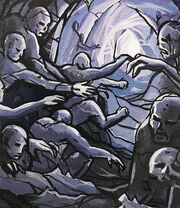Living walls were very rare undead monstrosities created from multiple living creatures.[1][3]
Description[]
To most creatures, these appeared to be mere ordinary walls of stone or brick. But to creatures who possessed truesight, the true seeing spell, a gem of seeing, or some other form of magic that saw through illusion, a living wall was seen to consist of greying and sinewy flesh, with various faces, hands, feet, and broken bones jutting from their surface. Whenever a living wall's flesh was exposed by cutting or blasting through it, a horrifying and nauseating stench was unleashed that could make the living pass out.[3]
Any creature that stood within 5 yards (4.6 meters) of a living wall could hear low moans of horror, pain, and sorrow issuing from it, including voices calling out, "Help me! Pull me out, free me!"[3]
Behavior[]
Living walls had varying degrees of intelligence and any creature assimilated into them would take on a chaotic evil alignment.[3] Their greatest motivation in life, above all others, was to destroy whoever created them.[4]
Abilities[]
Assimilation[]
Any humanoid or monster that died fighting a living wall was assimilated into its composition and lost forever, with only a wish spell being capable of removing them.[3] In order to be assimilated a creature needed to be corporeal. The types of creatures that a living wall was capable of assimilating included aberrations, animals, dragons, fey, giants, humanoids, magical beasts, monstrous humanoids, outsiders, and vermins.[1]
The bodies of assimilated creatures would continue to possess any unique abilities or memorized spells that they'd had in life. However, the abilities and spells of paladins and lawful good priests would have their nature reversed—for example, detect evil would become detect good, while the laying of hands would cause harm rather than heal.[3]
Any magical items or weapons on a creature's body would also be assimilated into a living wall's mass, concealed until it came time to fight. Magical items would continue to bestow their effect. General loot, non-magical armor, and backpacks were not assimilated.[3]
Whenever their creator died within 100 yards (91 meters) of them, a living wall would assimilate them and release the bodies of every other creature it had ever consumed. It would then revert to a structure of pure stone, forever trapping its creator inside.[4]
Resistances[]
The spell passwall could be used to pass through living walls. They were immune to all forms of planar spells or those from the time domain and time sphere. Whenever spells like ESP or speak with the dead were used on a living wall, the caster would hear only a cacophony of tortured minds and screams.[3]
Combat[]
Generally, living walls did not initiate combat with other creatures. However, tthe arms of assimilated creatures were liable to reach out and tug at those who came within 2 feet (61 centimeters) of the wall.[3]
The bodies of various assimilated creatures that composed a living wall's form would fight to the best of their abilities. For example, the bodies of fighters or warriors assimilated into its flesh would have their arms jut out through the wall with a weapon in hand, while the body of any assimilated wizard would be used to fight with spells.[3]
Ecology[]

A depiction of a living wall.
Living walls were constantly active, never resting. Being constructs, they did not reproduce.[3] The exact method for creating them was unknown, though it required several years of preparation and spellcasting. In addition, at least three corpses were needed.[4]
In the Domains of Dread, living walls could be created by the Dark Powers of the demiplane in response to despair and dread. This occurred whenever one living and sapient creature willfully entombed another in a wall, while the entombed cursed their killer in a loud enough scream for the land to hear their agony.[4]
Once dead, that victim's life force became trapped within the wall and within a matter of days it would be corrupted by madness, its alignment shifting to chaotic evil. At that point, any creatures that had died within 100 yards (91 meters) of the wall within the last month would arise and dig themselves from their graves, their corpses shambling to the wall and melding with it. Any subsequent deaths within that range would arise and wander to the wall as well.[4]
Relationships[]
Living walls were typically found in the lairs of malevolent creatures, serving as part of a torture chamber or covering the true entrance to a secret passageway.[3] Most cultures and all good-aligned creatures tried to destroy them whenever discovered.[4]
Appendix[]
External Links[]
- Living wall article at the Forgotten Realms Wiki, a wiki for the Forgotten Realms campaign setting.
- Living wall article at Mistipedia, a wiki for the Ravenloft campaign setting run by The Fraternity of Shadows.
References[]
- ↑ 1.0 1.1 1.2 Wolfgang Baur, Sean K. Reynolds (May 2006). “Creature Collection V”. In Erik Mona ed. Dragon #343 (Paizo Publishing, LLC), pp. 50–51.
- ↑ Beth Bostic, et al. (January, 2004). Denizens of Dread. Edited by Dale Donovan. (White Wolf Publishing), p. 135. ISBN 1-58846-951-4.
- ↑ 3.00 3.01 3.02 3.03 3.04 3.05 3.06 3.07 3.08 3.09 3.10 3.11 3.12 3.13 Doug Stewart (June 1993). Monstrous Manual. (TSR, Inc.), p. 224. ISBN 1-5607-6619-0.
- ↑ 4.0 4.1 4.2 4.3 4.4 4.5 Doug Stewart (June 1993). Monstrous Manual. (TSR, Inc.), p. 225. ISBN 1-5607-6619-0.
